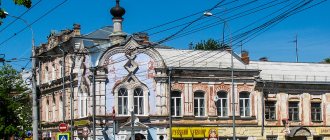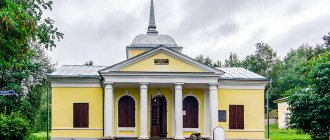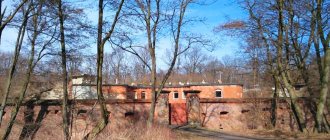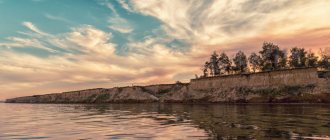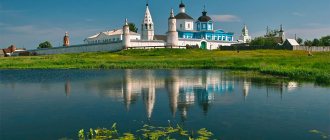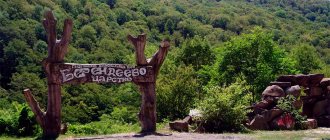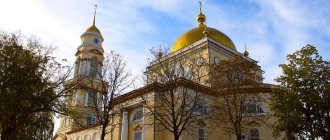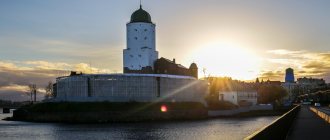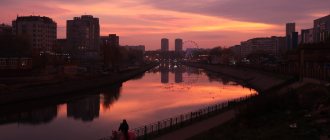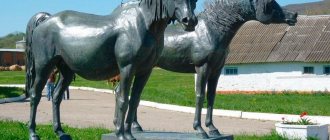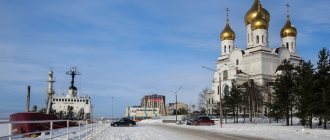December 24, 2022, 09:31
Today, residents of Kursk observed an interesting light phenomenon - a solar pillar in the sky.
[td]
The photographs were shared by the press service of the Kursk region administration.
Solar (light) pillars are an atmospheric phenomenon. It can be observed after sunset or before sunrise. Luminous columns occur at low temperatures when flat ice crystals form in the air.
It is curious that exactly a year ago, at the end of December, pillars of light in the sky were also observed in Kursk.
Ivan PROKHOROV, photo VK Kursk region
Share link:
Subscribe to “For Each Other”:
Yandex News Yandex Zen Google News YouTube Video
Sights of Kursk in one day
Kursk Museum of Local Lore
Kursk Museum of Local Lore
The museum opened its doors to visitors back in 1905. Since 1926, it has occupied a historic 19th-century mansion, the so-called Bishop's House.
Its exhibitions are divided into three sections: nature, pre-revolutionary history and Soviet history. Here you can see collections of ancient books, paintings, urban items and examples of folk art. A suitable location for cultural recreation of city guests.
Address: Lunacharskogo street, 6, Kursk
Opening hours: daily from 10:00 to 17:30
Entrance: for adults - 50 rubles.
Main Directorate of the Central Bank
Main Directorate of the Central Bank
In the center of the Course is the building of the Noble Land and Peasant Land Banks. It was created in 1914 according to Livchak’s design. The style is a mixture of eclecticism and modernism plus oriental motifs.
The windows of the second floor, decorated with majolica, look especially impressive. Connoisseurs of urban architecture should definitely look at this masterpiece.
Address: st. Gorkogo, 8, Kursk
Znamensky Cathedral
Znamensky Cathedral
In the historical part of Kursk there is the Cathedral Church of the Icon of the Mother of God “The Sign”. It was built from 1816 to 1826 in honor of the victory in the War of 1812. The cathedral is made in the style of classicism with a colonnade and strict symmetry required for this style.
This large-scale structure is 42 meters high. It can accommodate up to 5,000 people. The cathedral was seriously damaged both during the Second Patriotic War and in the post-war years. The interior of the temple was practically destroyed.
Now it is a functioning cathedral, where daily services are held. The interior of the temple was partially restored from historical photographs.
The stained glass window of the “Kursk Root Mother of God” above the altar deserves special attention. Both ordinary believers and connoisseurs of architectural styles willingly come here.
Address: Lunacharskogo street, 4, Kursk
Opening hours: daily from 7:00 to 17:30
Free admission
Resurrection and Elijah Church
Resurrection and Elijah Church
In the central area of the city there is a small Church of the Resurrection. It was created in 1768 on the site of a wooden church. In the 18th - early 19th centuries it was the cathedral church of Kursk.
The walls of the building are lined with bricks, and the windows and cornices are decorated with white stone. The original architecture of the temple has practically not been preserved.
The church was subject to several reconstructions. And in the 50s of the 20th century, the bell tower and portico were destroyed. The building looks interesting against the backdrop of modern houses and attracts city guests.
Address: Lenina street, 11, Kursk
Railway station building
Railway station building
Yamskaya station or Kursk-1 was created in 1869. From the point of view of architectural style, this is a combination of pseudo-Russian and pseudo-Gothic styles - an elegant low building made of red brick.
According to historians, the same design was used for the station as for the station in Orel. And to save money, the station was not even located in Kursk, but in Yamskaya Sloboda. At that time, the settlement was located 3 km from the city. That’s why the station was called “Yamsoka”.
For connoisseurs of city architecture and historical facts, it will be interesting to see the station with your own eyes.
Address: Lenina street, 83, Kursk
Opening hours: daily
Free admission
Museum "Kursk Nightingale"
Museum "Kursk Nightingale"
The museum has been operating since 2007. As the name implies, the exhibition is focused on the “symbol” of Kursk - the nightingale.
Here you can see photographs of nightingales (real ones), materials about the Nightingale the Robber, images of the legendary bird, and also listen to stories about people who have earned the title of “Kursk Nightingale” (usually opera and folk singers), even about the signature Kursk train “Nightingale” .
The museum captivates not so much with its educational content as with its original concept. Not a bad place for a walk with a child.
Address: Nikitskaya street, 74, Kursk
Opening hours: daily from 10:00 to 17:30
Entrance: for adults - 30 rubles.
Planetarium
Planetarium
The regional planetarium was opened in 1956. Documentaries about space are shown here, and lectures are given on the origin of the Universe. In general, all kinds of educational work is being carried out.
You can come here with your child (for an adult the lectures are quite simple). In addition, the establishment is located in the magnificent building of the Assembly of the Nobility.
Address: Sonina street, 4, Kursk
Opening hours: from 10:30 to 17:30
Entrance: for adults - 80 rubles, for children - 40 rubles.
Archive number No. 37 (467) dated September 16, 2003 - News
EXCURSION INTO HISTORY
Those who pass through Kursk say: “What an old city you have!” No wonder they say. After all, on September 25, the regional center will turn 971 years old. As the well-known wisdom says: “Moscow was still in its cradle, but Kursk was already fighting for Moscow.” In reality, little remains of the old city.
At the regional museum of archeology we were told that if we take the buildings of the pre-revolutionary period as old ones, then their ratio to new buildings is 1 to 500. The most ancient districts of Kursk are Streletskaya, Yamskaya, Pushkarnaya and Kozatskaya settlements, but even here there are almost no old houses left. After all, living in an architectural monument is not profitable; it is cheaper to build a new house. The same picture is on the oldest streets: Dzerzhinsky (formerly Kherson) and Lenin (formerly Moscow), which were practically rebuilt after the war. During an inventory in the 18th century, 26 stone buildings were counted in Kursk. Today, one of them has been preserved - the current museum of archeology.
According to legend, it belonged to the Moscow princes Romodanovsky, who ruled Kursk in the 17th century. Therefore, sometimes it is called the “Chamber of the Romodanovsky Boyars.” And although it has been proven that the house is no more than 260 years old, the beautiful name stuck. Of the non-residential buildings, the creation of which dates back to the mid-18th century, the Lower Trinity Church and St. Sergius-Kazan Cathedral still stand.
Much more buildings from the 19th century have survived. A striking example of this is a small two-story house at the intersection of Sadovaya and Lenin streets, where there is now a bookstore. The founder of the Kursk biofactory, Dikovsky, lived there. Nearby is the building of the diocese, a former teachers' seminary built in the second half of the 19th century.
If you go higher, on Zolotoy Street, 12, you can see a three-story building built by Count Kleinmichel. There used to be a city psychoneurological clinic there. Its walls, by the way, heard the sound of the steps of the Emperor and Autocrat of All-Russia Nicholas II, who during the First World War, in November 1914, visited wounded and sick soldiers in the military hospital located there.
Opposite the Shchepkin cinema there is a regional drug treatment clinic. In common parlance it is sometimes called the Governor's House. Why? It turns out that during the time of Catherine II, the Kursk governorship was established. A wooden house was built for the governors in the area of Pervomaisky Park and plastered, but it did not last long. Complaints began to come from officials: the roof was leaking, the floors were rotting, the walls were crumbling... Among the Kursk nobles, there was one who, out of respect for high-ranking officials, did not raise the price and sold the stone house on the former Khersonskaya street almost at cost, for 40 thousand. And since the beginning of the 19th century, the official residence of the Kursk governors was located there. There was a house church inside the building. Last year, representatives of the diocese came to the dispensary and tried to find an underground passage that began under the stairs leading to the second floor and was supposed to lead to the church that previously stood near the place where the shoe factory is now located. They examined the walls, which were more than a meter thick, but, unfortunately, found nothing.
There are completely unique buildings, the safety of which, unfortunately, is not monitored, but their loss will be irreparable for the history and architecture of Kursk. This is the small building of the merchant Deryugin - a building behind the burnt circus, consisting of three buildings, on the walls of which pre-revolutionary construction dates are lined with brick. Coarsely ground grain was made there, hence the unusual name for modern people. In Soviet times, the mill was still functioning, then there was a knitting factory there, but now the building is abandoned. There are several offices located in it, and the rest of the territory is in oblivion.
The building of the summer theater of the merchant's garden in Pervomaisky Park is one of the first reinforced concrete buildings in Russia. It’s interesting that when it was built, they planned to make the entrance on the side of the Znamensky Cathedral, that is, in the opposite direction to how it is located now. But, according to the laws of the Russian Empire, the entrance to entertainment establishments had to be at a certain distance (about 100 fathoms) from the church. In order to comply with the law, the architect Peryatyatkovich lacked quite a bit. However, not hoping to defeat the stubbornness of the holy fathers, he simply turned the construction 180 degrees.
Anna NARYKOVA
Share link:
Subscribe to “For Each Other”:
Yandex News Yandex Zen Google News YouTube Video
Sights of the surrounding area of Kursk
Indigenous deserts
Indigenous deserts
One of the most famous monasteries in Russia. It lies 30 km from Kursk. Associated with the veneration of the icon of the Mother of God “The Sign”. The monastery was founded at the end of the 16th century, but the buildings of that time have not survived. The deserts received their modern appearance in the 18th–19th centuries.
The desert is still a popular place of pilgrimage. In addition, it has considerable historical significance.
Address: Kursk region, Zolotukhinsky district, Svoboda metro station; GPS: 51.97313, 36.31091
Maryino Estate
Maryino Estate
The palace and park ensemble was built in 1820. The distance between Kursk and Maryino is about 100 km. The family of the Baryatinsky princes lived here for more than 100 years. The original style of the main building was Empire style, but after 50 years the estate was extensively rebuilt, giving it eclectic features.
Now there is a departmental sanatorium here; you can get inside only with a guided tour. In addition to the house, it is worth paying attention to the magnificent landscape park.
Address: Tsentralnaya street, 1, Maryino village, Kursk region; GPS: 51.58717, 34.9429
Opening hours: daily from 8:00 to 20:00
Streletskaya steppe
Streletskaya steppe
The biosphere reserve of the Kursk region was formed in 1935. It is located 20 km south of Kursk. It is famous for its enormous species richness of flora and fauna.
A place where you can combine active recreation with educational ones. Here you can walk along hiking trails, you can look at the famous stone women, and visit the Museum of Nature. Nature lovers will be delighted.
Address: p/o Zapovednoe, Kursk region; GPS: 51.56905, 36.08577
Estate of Count Nelidov
Estate of Count Nelidov
Construction of the early 19th century near Kursk. A spacious park on the banks of the Seim River with a Gothic building. The estate was erected for the governor of the Kursk province, Count Nelidov.
Now there is a sanatorium "Moscow". Unfortunately, almost nothing has been preserved from the luxurious interiors and well-kept park. It’s worth coming here for the original architecture of the building and the magnificent nature around.
Address: Moscow 1st, Kursk region; GPS: 51.71272, 36.09586
Trains Moscow - Kursk from Kursky station
On the route we are interested in, most flights depart from Kursky Station. Both direct ambulances (“Swallows”) and passing trains depart from it.
For example, why not take the branded train? On No. 057B "Prioskolye" (Moscow - Stary Oskol) or No. 071B "Belogorye" (Moscow - Belgorod). The fastest is No. 743B, going to Belgorod (5 hours 25 minutes), the slowest is night No. 141B to Kursk (12 hours 4 minutes).
You can see all the trains that depart from Kursky Station on the display from Tutu.Ru, presented just above.
Trains arrive at the Kursk railway station.
Where to go in Kursk and what else to see
Church of the Assumption of the Virgin Mary
Church of the Assumption of the Virgin Mary
The Catholic Church was built at the end of the 19th century. The tall brick building was built in the neo-Gothic style. The central façade is complemented by two pointed towers.
The building did not serve long as a temple; it was closed in 1938. After that, an anti-religious museum, warehouse, and cultural center were located in the temple building. The temple is known for its excellent acoustics; organ concerts are often held here.
Address: Marata street, 31, Kursk
Opening hours: daily
Free admission
Official website: https://catholic-kursk.ru/raspisanie/
Drama Theater
Drama Theater
The oldest theater in Russia, founded in 1792. For a long time it bore the name of the actor Shchepkin, and in 1937 it was renamed the Pushkin Theater.
The repertoire includes mainly classical plays. In addition, the Jazz Province jazz festival is held here. The theater is suitable for adults who appreciate art.
Address: Lenina street, 26, Kursk
Cash desk opening hours: 10:00 - 20:00 without breaks and days off
Puppet Theatre
Puppet Theatre
The theater occupies the building of a former gymnasium. His work began in 1944 quite modestly - the troupe consisted of only 5 people. Moreover, they were also the creators of puppets and props.
By the 70s of the 20th century, puppet theater gained fame in the USSR. Performances for adults appeared in his repertoire. Today it is one of the most popular cultural institutions in the region. Tourists of any age should go to at least one performance.
Address: Radishcheva street, 2, Kursk
Cash desk opening hours: daily from 10:00 to 19:00
Philharmonic
Philharmonic
The Philharmonic was formed in 1936. At first, her activities were limited to organizing tours of famous performers. But soon their own opera ensemble was created.
Since 1983, the Philharmonic has occupied a building on Perekalsky Street (previously it housed a drama theater). This is a brick building from the early 20th century, built in the Art Nouveau style.
In addition, since 2022, the institution has a second site in the former Officers' House. Music lovers will be interested in the Philharmonic's opera performances, which are often held at the Philharmonic.
Address: Perekalsky street, 1, Kursk
Opening hours: from 09:00 to 18:00, break from 13:00 to 14:00
Circus
Circus
The circus was organized in 1971. But he seemed to be haunted by misfortunes - twice the circus building was destroyed by fire. In 2011, the building was built almost anew. Performances in the circus are given daily at 12:00 and 16:00. Duration: 2–3 hours. A suitable place to relax with a child.
Address: Alexandra Nevsky street, 4, Kursk
Opening hours: from 9:00 to 17:30
Literary Museum
Literary Museum
On one of the central streets of the city there is a literary museum of Kursk. It was created in 2009. The museum's exhibitions tell about the life and work of writers of the Kursk region, starting from the 11th century. Particular attention is paid to the works of writers Vorobyov and Nosov.
In addition, the museum is interesting for its building - a historical mansion from the early 19th century. The museum will be especially interesting for people who love literature and art.
Address: Sadovaya street, 21, Kursk
Opening hours: daily from 9:00 to 17:30
Entrance: for adults - 50 rubles.
Vvedensky Temple
Vvedensky Temple
In the eastern part of the city, in the so-called Yamskaya Settlement, stands the Vvedensky Church (1761). This is a small one-domed temple. Its massive walls and huge dome are somewhat lightened by high windows. After 100 years, a bell tower was erected near the main task, but it has not survived to this day.
In 2007, the church was extensively reconstructed, and a new bell tower was built. Those who understand architectural styles should take a look at these places.
Address: Dubrovinskogo street, 40, Kursk
Opening hours: daily
Free admission
Ascension Church
Ascension Church
In the historical district of Kozatskaya Sloboda there is the Church of the Ascension of the Lord. It was built in 1887 with money raised by the townspeople. Surprisingly, the temple worked almost without interruption throughout the 20th century.
The main style of the building is late classicism, but its decor is complemented by baroque elements. Again, believers and connoisseurs of architectural delights should come here.
Address: V. Kazatskaya street, 131, Kursk
Opening hours: daily
Free admission
Noble Assembly building
Noble Assembly building
Historic mansion in the city center, built in 1877. The three-story house was created in the then fashionable eclectic style. The most impressive is the façade from Sonina Street.
It is faced with brick, decorated with carved cornices, numerous pilasters, columns and a metal grill on the roof. Even people who don’t understand architecture like this magnificent building, almost a palace.
Address: Sonina street, 4, Kursk
Art gallery named after. Deineki
Art gallery named after. Deineki
The gallery has been open to the public since 1935. Located on Radishcheva Street (since 1980). The basis of the museum collection was 200 paintings donated by the local Museum of Local Lore.
Today, the collection includes 8,000 exhibits (paintings, graphic canvases, sculptures). It will be of interest to people with artistic taste, connoisseurs of painting of the 18th and 19th centuries.
Address: Radishcheva street, 85, Kursk
Opening hours: daily from 10:00 to 17:00
Entrance: for adults - 60 rubles, for children - 000 rubles, children under 0 years old - free
Holy Trinity Monastery
Holy Trinity Monastery
A convent for women, created in 1623. Buildings from the late 17th century have survived to this day. This is one of the most famous and authoritative convents in Russia. So at the end of the 19th century, about 1000 people lived here.
According to legend, the parents of Seraphim of Sarov often came here with their son. People come here to pray and also to admire the ensemble of monastery buildings.
Address: Kursk, st. M. Gorky, 13/1
Opening hours: daily
Free admission
Official website: https://kursk-sestry.ru/
Kursk Museum of Archeology
Kursk Museum of Archeology
Founded in 1993 on the basis of a branch of the local history museum. Located in a historical building of the 18th century (the house of the merchant Khloponin). Its exhibitions tell about the history of the Kursk region from the Stone Age to the Middle Ages.
Here you can see what the workshops of ancient people, their housing and clothing looked like. The museum is intended for all those who are curious and interested in archaeology.
Address: Pionerov street, 6, Kursk
Opening hours: daily from 9:30 to 17:00
Waterpark "Miracle Island"
Waterpark "Miracle Island"
In the northern part of the city there is the Kursk water park. It started work in 2008. Today it is a favorite of local and visiting children. Here you can swim in the pools, have fun on the water slides, and relax in the lounge area.
For adults there is a spa area with a sauna, hammam and salt cave. And, of course, you can have a snack in the food court. This is an ideal place for a family holiday.
Address: Soyuznaya street, 26, Kursk
Opening hours: daily from 10:00 to 22:00; Monday–Wednesday — closed
Entrance: for adults - 1200 rubles, for children - 800 rubles, children under 90 cm - free
Ticket price
Before talking about prices, it is necessary to clarify that Russian Railways is implementing a “Dynamic Pricing” program, which includes entire trains (such as “Lastochka”) and individual cars (coupe, SV, luxury). This means that the cost varies depending on a number of factors, the main one being demand. The more often tickets for a particular train are purchased, the more expensive they are. For this reason, we recommend purchasing boarding passes in advance.
You can read more about the program on the Russian Railways website.
At the start of sales (90 days before departure) the prices are as follows: seat from 810 rubles , reserved seat from 1,670 rubles , coupe from 2,000 rubles , SV 5,250 rubles .
Best hotels in Kursk
Related materials:
- 29 best attractions in Orel,…
- 32 sights of Kronstadt that are worth visiting
- 31 attractions of Novorossiysk to visit
- 28 best attractions in Belgorod,…
- 43 best attractions in Minsk,…
- 33 attractions of Bakhchisaray that are worth visiting
- 27 best attractions of Bryansk,…
- 37 must-see attractions in Dubai
- 26 attractions of Svetlogorsk that…
Did you like the article? Share with friends:
